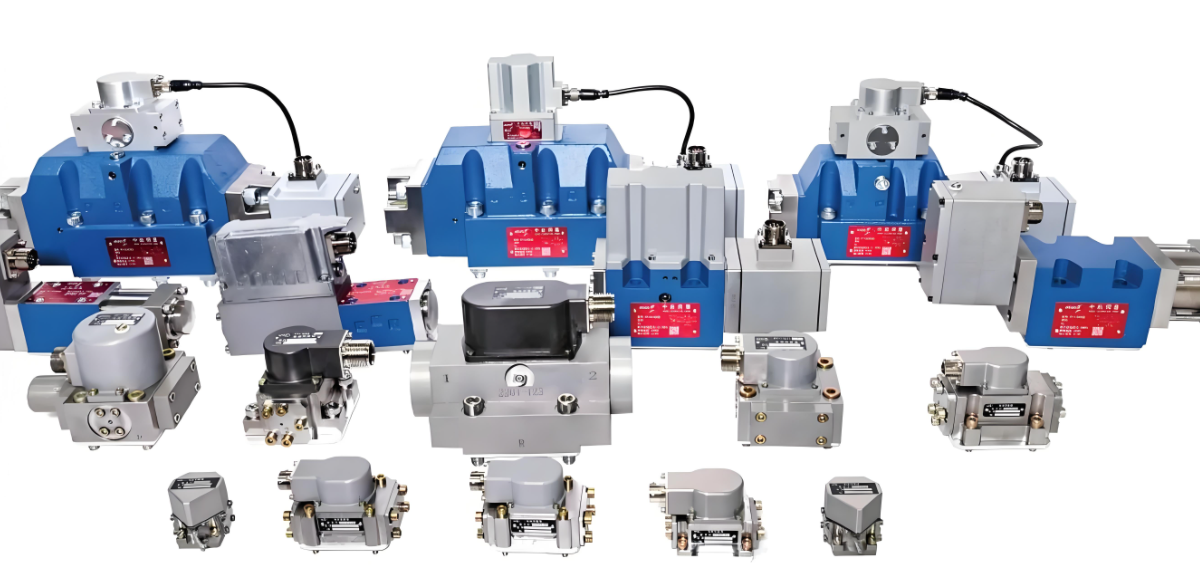1. Introduction
The electro-hydraulic servo valve is a critical component in modern hydraulic systems, enabling precise control of fluid flow and pressure in various industrial and aerospace applications. By converting electrical signals into proportional hydraulic actions, these valves enhance system efficiency, responsiveness, and automation. This article explores the working principles, key components, applications, and recent advancements in electro-hydraulic flow control servo valves.
2. Working Principles
An electro-hydraulic servo valve operates by integrating electrical and hydraulic systems to achieve precise flow regulation. The basic working principle involves:
- Electrical Signal Input: A controller (e.g., PLC or computer) generates an electrical signal (typically 0-10V or 4-20mA) corresponding to the desired flow rate.
- Signal Amplification: The input signal is amplified by a servo amplifier to drive the valve’s torque motor or proportional solenoid.
- Spool Movement: The amplified signal actuates a spool or flapper-nozzle mechanism, adjusting the valve opening to regulate hydraulic fluid flow.
- Feedback Mechanism: A position sensor (e.g., LVDT or potentiometer) monitors the spool position and provides feedback to the controller, ensuring precise control.
This closed-loop control system ensures high accuracy, fast response, and minimal hysteresis.
3. Key Components
An electro-hydraulic servo valve consists of several critical components:
- Torque Motor/Proportional Solenoid: Converts electrical signals into mechanical motion to move the spool.
- Spool and Sleeve: The spool’s position determines the flow path and rate, while the sleeve provides precise flow control.
- Flapper-Nozzle Mechanism (in some designs): Enhances sensitivity and dynamic response.
- Position Sensor: Provides real-time feedback on spool position for closed-loop control.
- Hydraulic Amplifier (Pilot Stage): Amplifies the initial signal to generate sufficient force for spool movement.
4. Applications
Electro-hydraulic servo valves are widely used in industries requiring precise fluid power control, including:
- Aerospace: Flight control surfaces (e.g., ailerons, rudders) in aircraft.
- Industrial Automation: Hydraulic presses, injection molding machines, and robotics.
- Marine Systems: Ship steering and propulsion control.
- Wind Turbines: Pitch and yaw control systems.
- Mobile Hydraulics: Excavators, cranes, and agricultural machinery.
These valves are preferred due to their high precision, fast response, and ability to handle high pressures and flow rates.
5. Advancements and Future Trends
Recent advancements in electro-hydraulic servo valves focus on improving performance, reliability, and energy efficiency:
- Digital Control Integration: Smart valves with embedded microprocessors enable adaptive control and predictive maintenance.
- Reduced Hysteresis and Leakage: Advanced materials (e.g., ceramic coatings) minimize internal leakage and improve response time.
- Compact and Lightweight Designs: Miniaturized valves for aerospace and robotics applications.
- Energy-Efficient Systems: Integration with variable displacement pumps to reduce energy consumption.
- AI-Based Predictive Maintenance: Machine learning algorithms detect wear and predict valve failures before they occur.
6. Conclusion
The electro-hydraulic servo valve remains a vital technology in modern hydraulic systems, offering unmatched precision and control. With ongoing advancements in digitalization, materials science, and energy efficiency, these valves will continue to play a key role in automation, aerospace, and industrial applications. Future developments will likely focus on smart, adaptive systems that enhance reliability and reduce operational costs.
References (Optional, if needed for academic purposes)
- Merritt, H. E. (1967). Hydraulic Control Systems. Wiley.
- AGMA & ISO Standards on Hydraulic Valves.
- Recent research papers on smart hydraulic systems.

